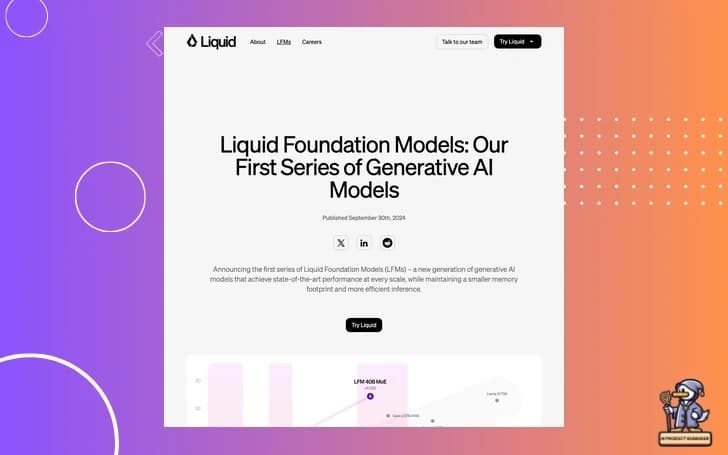🦆 Welcome to QuackChat: The DuckTypers' Daily AI Update!
Hello, my brilliant Ducktypers! It's Prof Rod here, ready to dive into the exciting world of AI developments. Today, we're going to explore a groundbreaking announcement that's making waves in the AI community. So, grab your thinking caps, and let's quack open this fascinating topic!
🌊 Liquid AI: The New Wave in Foundation Models

Alright, Ducktypers, let's start with a splash! Liquid AI has just unveiled their new Liquid Foundation Models (LFMs), and they're claiming to be the next big thing in AI. Now, I know what you're thinking - "Prof. Rod, we hear about 'next big things' all the time!" But stick with me, because this one's got some serious credentials behind it.
🚀 Benchmark Bonanza: LFMs Aim High
Liquid AI isn't just making waves; they're causing a tsunami of excitement with their performance claims. They're boasting superior results on benchmarks like MMLU (muh-loo), which stands for Massive Multitask Language Understanding. Now, for those of you who might be new to our Ducktyper community, MMLU is like the decathlon of AI tests - it covers everything from basic math to complex reasoning.
But here's where it gets really interesting:
- They've launched models in 1B, 3B, and 40B sizes
- Their 1.3B model is challenging much larger competitors
- They're calling out inefficiencies in other models
Now, Ducktypers, let's pause for a moment. What do you think about these claims? Have you had experience with other models that seemed to punch above their weight class?
🧠 The Minds Behind the Magic
Now, I always tell my students to look at the team behind the tech, and Liquid AI doesn't disappoint. They've got some serious brainpower from MIT backing them up. This is like having the dream team of AI working on your project!
Let's break down why this matters:
- Academic rigor: MIT researchers bring a depth of theoretical knowledge
- Practical experience: These folks have likely worked on cutting-edge projects before
- Network effect: Connections in the academic world can lead to collaborations and faster progress
Call to Comment: Ducktypers, how important do you think the pedigree of the team is in AI development? Does it influence your trust in a new technology?
💻 What This Means for AI Developers and Researchers
Okay, Ducktypers, let's get into the nitty-gritty. What does this mean for you, whether you're a seasoned AI developer or a curious student?
-
Efficiency: If LFMs can deliver better performance with smaller models, we're talking about reduced computing costs and faster training times.
-
Accessibility: Smaller, more efficient models could democratize AI, making it more accessible to developers with limited resources.
-
New Possibilities: With improved performance, we might see AI applications in fields where they were previously impractical.
Let's look at a simple pseudocode example to illustrate how this might change your workflow:
# Before LFMs
def train_large_model():
model = load_huge_model(size="40B")
for epoch in range(100):
# Train for days or weeks
train(model, data, epochs=1)
return model
# With LFMs
def train_efficient_model():
model = load_liquid_model(size="1.3B")
for epoch in range(10):
# Train for hours or days
train(model, data, epochs=1)
return model
# The difference in resource usage and time could be staggering!
Call to Comment: Developers, how would more efficient models change your approach to AI projects? What new ideas would you tackle if compute constraints were less of an issue?
🔮 The Future of AI Model Architecture
Now, let's put on our futurist hats for a moment, Ducktypers. If Liquid AI's claims hold up, we could be looking at a paradigm shift in how we approach AI model architecture.
Here are some potential implications:
- End of the Size Race: We might see a shift from "bigger is better" to "smarter is better" in model design.
- Energy Efficiency: Smaller, more efficient models could significantly reduce the carbon footprint of AI.
- Specialized Models: This could pave the way for more task-specific models that excel in particular domains.
Imagine a world where instead of one massive model trying to do everything, we have a network of smaller, specialized models working in harmony. It's like the difference between a Swiss Army knife and a well-equipped toolbox!
Call to Comment: What's your vision for the future of AI model architecture? How do you think approaches like Liquid AI's might shape that future?
🎓 Wrapping Up: The Liquid AI Revolution
Alright, Ducktypers, let's bring it all together. We've covered a lot of ground today:
- Liquid AI's bold entrance into the foundation model scene
- Their impressive benchmark claims
- The potential impact on AI development and research
- The possible future of AI model architecture
Remember, as exciting as these developments are, it's crucial to approach them with a critical mind. That's what being a Ducktyper is all about - curiosity tempered with skepticism, and excitement balanced with analysis.
Final Call to Comment: What aspect of Liquid AI's announcement intrigues you the most? What questions would you ask their team if you had the chance?
As we close out today's QuackChat, I want you to ponder this: How might more efficient, powerful AI models change your field of study or work? The possibilities are as vast as they are exciting!
Until next time, keep questioning, keep learning, and above all, keep quacking! This is Professor Rod, signing off from QuackChat: The DuckTypers' Daily AI Update!
P.S. If you found this update valuable, don't forget to like, subscribe, and share with your fellow tech enthusiasts. Let's grow this community of curious minds building the AI products of the future together!


